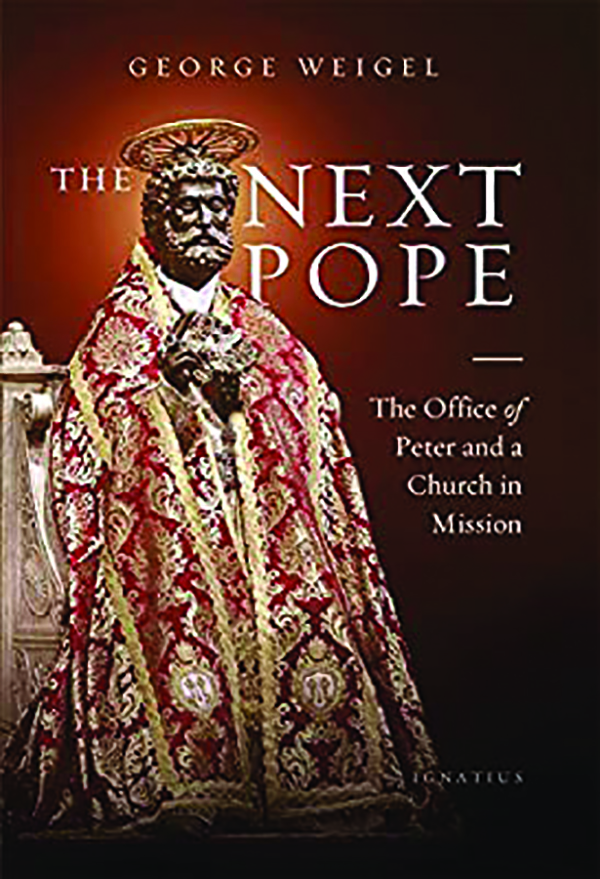George Weigel’s pronouncements on the state of Catholicism and the papacy are always worth heeding. His authoritative biography of Pope John Paul II, Witness to Hope, easily remains the best account of John Paul II’s mind and historic life. But the Catholic Church faces a new slate of problems as it continues to grapple with perennial ones. In much of the West, it does so with none of the right friends and all of the wrong enemies.
The Catholic Church, Weigel observes near the beginning of his new book, The Next Pope, is undergoing its fifth epochal transition: what he calls the “New Evangelization.” This epoch began with the Second Vatican Council in 1962–65, which ended the fourth epoch of “Counter Reformation Catholicism.” Vatican II called for evangelical fervor and for engagement with the unbelieving world, but it has nearly broken upon the shoals of secular modernism, internal divisions, and, it must be said, the sexual and financial crimes of some clergy.

Weigel’s book is an attempt to spell out spiritual criteria for the next pope — to explain, in his view, how the next pope should act in order to revive the church’s fortunes in the modern world. There are many elephants in the room here, but one of the biggest, prudently left unnamed by Weigel, is Pope Francis’s pontificate. Weigel drops small vignettes throughout the book of what the next pope must do and not do. The negative examples often describe Francis’s style of interventions and tactics, including what sometimes seems to be his progressive conflation of the values of the present moment with truth itself. “Making a mess,” as Francis once urged people to do, has produced precisely that: a mess.
Weigel argues that the church must remain in continuity with its ancient teachings and tradition. But this is easier said than done. At Vatican II, the church attempted to open itself to the modern, secular world while insisting that its fundamental teachings had remained unchanged, and it has been hobbled ever since by internal conflicts over the meaning and purposes of the council. Yet strife and contention within the church aren’t new. What has proved true, Weigel contends, is that those parts of the church that accepted the underlying continuity of the council with tradition and doctrine are alive and flourishing, even under “challenging cultural and political circumstances,” while the parts of the church, especially in the West, that have interpreted Vatican II as “a radical break with the Catholic past” have floundered. Their attempts at theological, liturgical, and moral innovation have emptied pews and reduced the function of the church to that of just another NGO. The pope who is to come must build on the work of the former or risk further disillusionment and decay.
Whoever comes after Francis, Weigel argues, must understand that he leads a church immersed in “apostolic times” — in other words, because the church is no longer protected by cultural and governmental authorities, it must again preach and evangelize with the same fervor of its early days. According to Weigel, the next pope must build on the church as “a communion of disciples in mission.” But this requires holding the church together. The next pope must not put his will and desire ahead of the church’s need for the whole of mission, doctrine, teaching, and sacraments to be thought and practiced together. Weigel gently provides a number of instructive examples for our future pontiff to heed, most of which provide a sharp contrast to the acts of Pope Francis.
For example, Weigel argues that a pope must be the “Servant of the Servants of God” and thus cannot “speak in such a way as to identify his personal opinions with the settled teaching of the Church.” One can think of several examples of Pope Francis doing just the opposite, but the one that looms largest was his off-the-cuff response to a question from a journalist about homosexuality: “Who am I to judge?” Given the implicit relativism that most people hear whenever that phrase is uttered, Francis’s words were immediately interpreted as moving the church’s teachings on sexual morality toward contemporary mores. That this was not and could not be the case did not matter. Francis’s lack of discipline sowed confusion and seemed to traffic in the banal egalitarianism of our time.
Weigel affirms that the church’s future leader must hold doctrine and mercy together. While divine mercy is “comforting,” it can’t be “detached from purification.” Mercy cannot be an excuse for ignoring what the church proclaims as binding doctrine. Yet Francis, in the famous footnotes 329 and 351 of his 2016 apostolic exhortation Amoris Laetitia, has given strong indications that he is open to allowing certain couples who have been divorced and remarried outside of the church to receive communion — a clear violation of Catholic teaching. Certainly, that is what some Western European bishops have taken the pope to mean despite clear efforts from the church hierarchy to dispel such interpretations.
The church must further insist that it remains free to teach and govern itself apart from the state. Weigel all but states that the next pope will have to repudiate the secret Vatican-China deal made in 2018, which imposes unity on the underground and patriotic churches in China and grants the vicious and atheistic Chinese state virtual control over the appointment of bishops while seeming to prohibit the church from criticizing Beijing’s human rights abuses. Francis, who speaks out about everything, has been shockingly quiet about China’s appalling attacks on human dignity.
The next pope inherits something of a mess, and he will need more than a “field hospital” to heal the confusion, errors, and weaknesses that percolate through it. He will need to recover the church’s fighting faith.
Richard M. Reinsch II is the editor of Law & Liberty and the host of LibertyLawTalk. Follow him on Twitter @Reinsch84.

